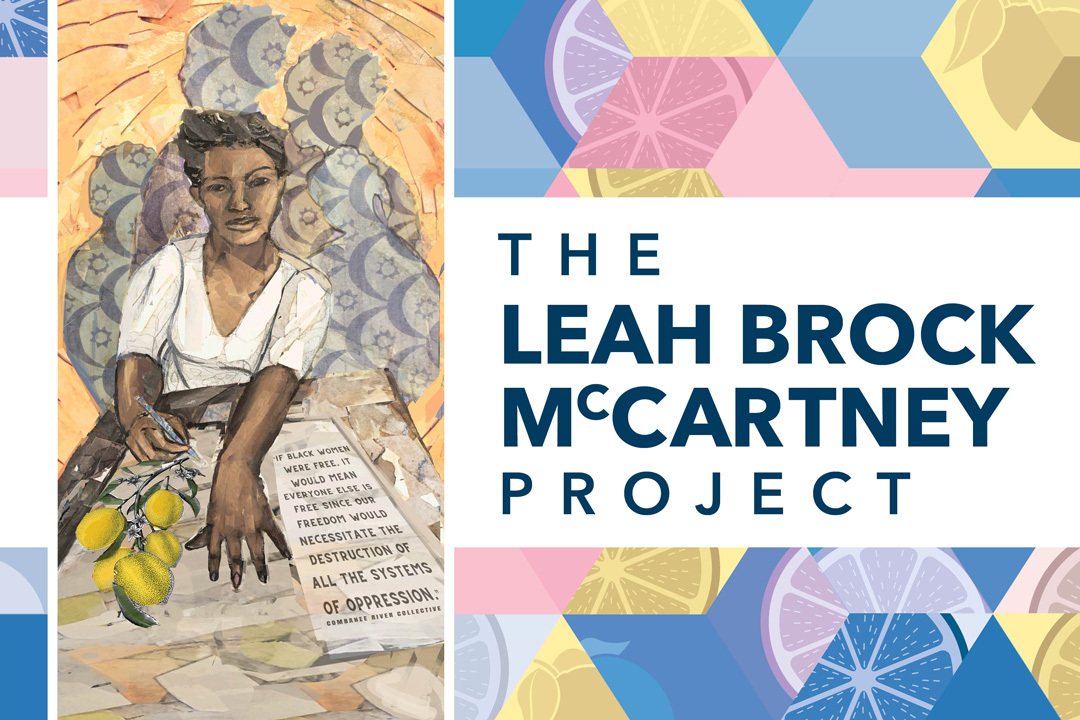An alumni-driven initiative is raising funds to commemorate George Washington University’s first Black alumna with a mosaic that would be installed on the Gelman Library facade.
Once funded by donations, the approximately 17-by-34-foot ceramic tile and glass mural will spotlight the legacy of Black women at GW and honor Leah Brock McCartney, who earned a Bachelor of Laws in 1954, became the first Black woman to earn a law degree from GW and went on to a career as a pioneering judge.
Artist Chanel Compton plans to create the mosaic with the assistance of local artists and donations from alumni and members of the GW community.
“This is the crystallization of a dream come true,” said Naseem Haamid, B.A. ’21, who first conceived of the project along with Owen Manning, B.B.A. ’21. A former political science major who now attends the University of the District of Columbia David A. Clarke School of Law, Haamid called the mosaic “a gift to the GW community, a gift to the D.C. community and a gift to the nation at large.”
Haamid and Manning first learned about McCartney’s life and legacy during the fall 2019 semester while taking a class called Black Feminist Theory—Lemons Into Lemonade: Black Women in the US. Taught by Jordan Shelby West, GW’s associate vice provost for diversity, equity and community engagement, the class was grounded in practices of Black Feminist Theory, such as truth telling and creating space for voices and stories that are untold and historically marginalized. Students explored and made meaning of the theoretical, historical, and literary frameworks of Black Feminism, including concepts such as intersectionality, womanism, and more.
Manning and Haamid proposed a mural commemorating McCartney as part of a class assignment. But when the course ended and the nation reckoned with racial injustice after tragedies like the murder of George Floyd, the two students developed their idea into a public art piece on the GW campus.
To both Haamid and Manning, McCartney’s story was largely unknown before taking West’s class. Born in 1911 in Ellisville, Miss., McCartney spent years as a teacher before enrolling in GW. She received an L.L.B. degree in 1954, the same year that GW abolished restrictions on minority student admissions. (Previously, Black students could only attend evening classes.) In 1968, she became the first Black woman to earn a law degree from GW, graduating with the highest grade point average in her third-year class despite working full-time during her studies.
During her storied legal career, she was the first female municipal judge of record in Missouri, taught law at the University of Tulsa and became the first Black person to serve on the Missouri Public Service Commission.
“This is something that is rooted in love, and I think it’s something that is particularly special when you’re thinking about how many people this has the potential to impact going forward,” said West.
Mindful of the importance of collaborating with Black women on the project, the students turned to artist Compton, executive director of both the Maryland Commission on African American History and Culture and the Banneker-Douglass Museum in Annapolis, to help design and create the mural. Noted for her passionate artistic expression of Black experiences, Compton was intrigued after just one telephone conversation with Manning. “I was so impressed that these students cared so much and wanted to leave a legacy at their university,” she said. “It was inspiring to me, and I wanted to support that.”
After meeting with Haamid, Manning and West, Compton embarked on her own extensive research into McCartney’s life. Her design—titled “A Seat at the Table: A Tribute to Leah Brock McCartney”—centers around a portrait of McCartney sitting at a writing table. On one side of the table are lemons reflecting the name of West’s course and the project’s inspiration. On the other side is a quote chosen by Manning and Haamid from a 1970s Black feminist organization called the Combahee River Collective: “If black women were free, it would mean everyone else is free, since our freedom would necessitate the destruction of all the systems of oppression.”
“I wanted to make sure the design, the composition, the imagery was strong and impactful,” Compton said, “because it’s going to be such a strong statement for the university when it comes to inclusion and amplifying Black women’s voices.”
Manning and Haamid continue to lead all aspects of the project. The team credits an early $10,000 pledge from the GW Luther Rice Society with helping kickstart their fundraising efforts and giving them the confidence to forge ahead with the project.
“This is about so much more than artwork. It’s so much more than a mural going up on a wall,” Manning said. “It’s about supporting and honoring Black women and telling the stories that need to be told.”
Show your support for honoring Judge McCartney, GW's first Black alumna, and the legacy of Black women at GW by donating to the project.




